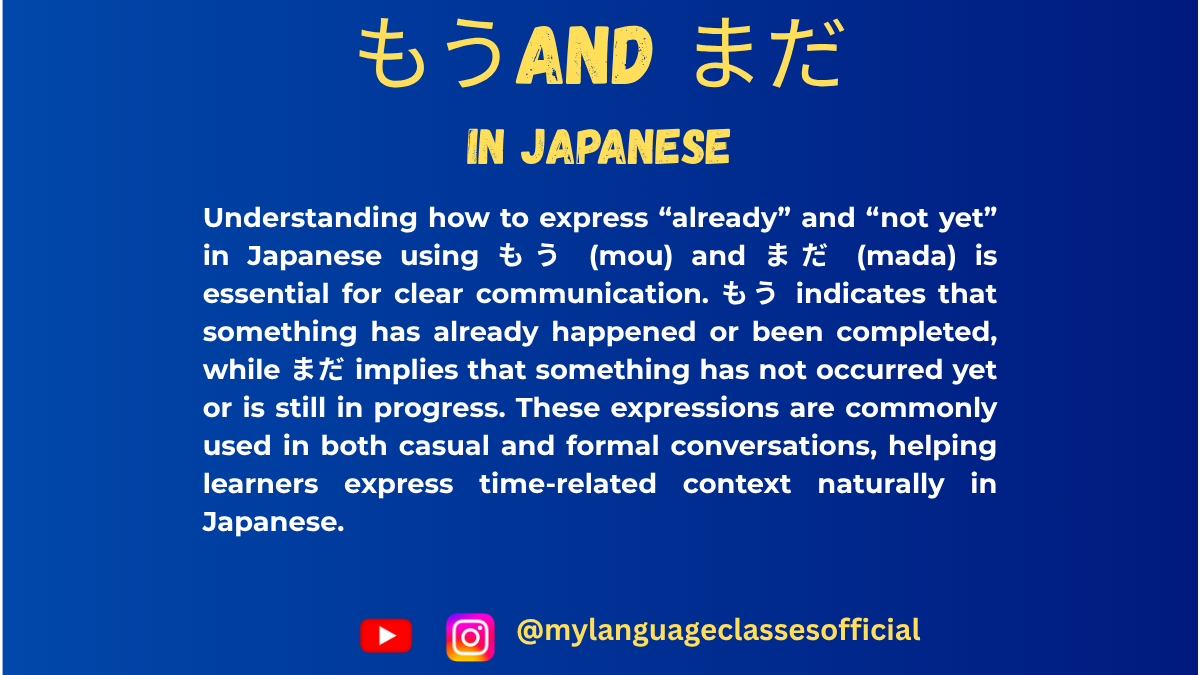Your cart is currently empty!
Tag: beginner Japanese grammar tips
-

How to Say “Already” & “Not Yet” in Japanese もう and まだ | My Language Classes
Expressing “Already” and “Not Yet” in Japanese
When learning Japanese, one of the first challenges is understanding how to express “already” and “not yet.” In English, these concepts are simple, but in Japanese, we rely on two essential words: もう (mou) and まだ (mada). By the end of this post, you’ll master how to use these two expressions correctly and naturally.
1. Understanding もう (“Already”)
The word もう translates to “already” in English and is used to indicate that an action has already been completed or a state has been reached.
Examples of もう in Sentences
- もう食べました。
Mou tabemashita.
“I already ate.” - もう終わりましたか?
Mou owarimashita ka?
“Have you already finished?” - 彼はもう来ました。
Kare wa mou kimashita.
“He has already come.”
Key Point for もう:
- Use it with the past tense of a verb to show completion.
- It often expresses a sense of surprise or confirmation.
2. Understanding まだ (“Not Yet”)
On the other hand, まだ means “not yet” and expresses an action or state that has not happened or is still ongoing.
Examples of まだ in Sentences
- まだ食べていません。
Mada tabete imasen.
“I haven’t eaten yet.” - まだ終わっていない。
Mada owatte inai.
“It’s not finished yet.” - 彼はまだ来ていません。
Kare wa mada kite imasen.
“He hasn’t come yet.”
Key Point for まだ:
- Use it with the negative form of a verb.
- It implies that something is expected to happen or still in progress.
3. Using もう and まだ Together
To create a clear contrast, you can use もう and まだ in conversations:
- もう食べましたか?
Mou tabemashita ka?
“Have you already eaten?”- Answer (Yes): もう食べました。(Mou tabemashita.) – “I already ate.”
- Answer (No): まだ食べていません。(Mada tabete imasen.) – “I haven’t eaten yet.”
This contrast helps clarify whether something has already occurred or is still pending.
4. Common Expressions Using もう and まだ
Here are a few handy expressions that use these words:
- もういいです。 (Mou ii desu.) – “It’s okay now.” / “I’m done.”
- まだまだです。 (Mada mada desu.) – “I still have a long way to go.” (Often used humbly about one’s skills or progress.)
5. Summary: Quick Reference Table
Word Meaning Usage Example もう Already Past/Complete Actions もう行きました。 (Mou ikimashita.) – “I already went.” まだ Not Yet/Still Negative or Ongoing まだ行っていません。 (Mada itte imasen.) – “I haven’t gone yet.”
6. Practice Time!
Try filling in the blanks with もう or まだ:
- ( )宿題を終えましたか? (… shukudai o oemashita ka?)
“Have you finished your homework already?” - いいえ、( )終わっていません。
“No, I haven’t finished yet.”
Answers:
- もう
- まだ
By practicing もう and まだ, you’ll gain confidence in expressing whether something has “already” happened or “not yet.” Keep listening to native speakers and trying these phrases in daily conversation—まだまだ there’s plenty to learn, but you’re already doing great!
What do you think about these tips? Let me know if you もう understand or if you’re まだ unsure—leave a comment below! 😊
If you enjoyed this lesson, be sure to check out more posts like this on my blog at My Language Classes. Don’t forget to subscribe my YouTube channel and follow me on Instagram for the latest language learning tips and lessons. Leave a comment below to share your thoughts, or ask any questions you have about nouns.
Happy learning! 😊
- もう食べました。
